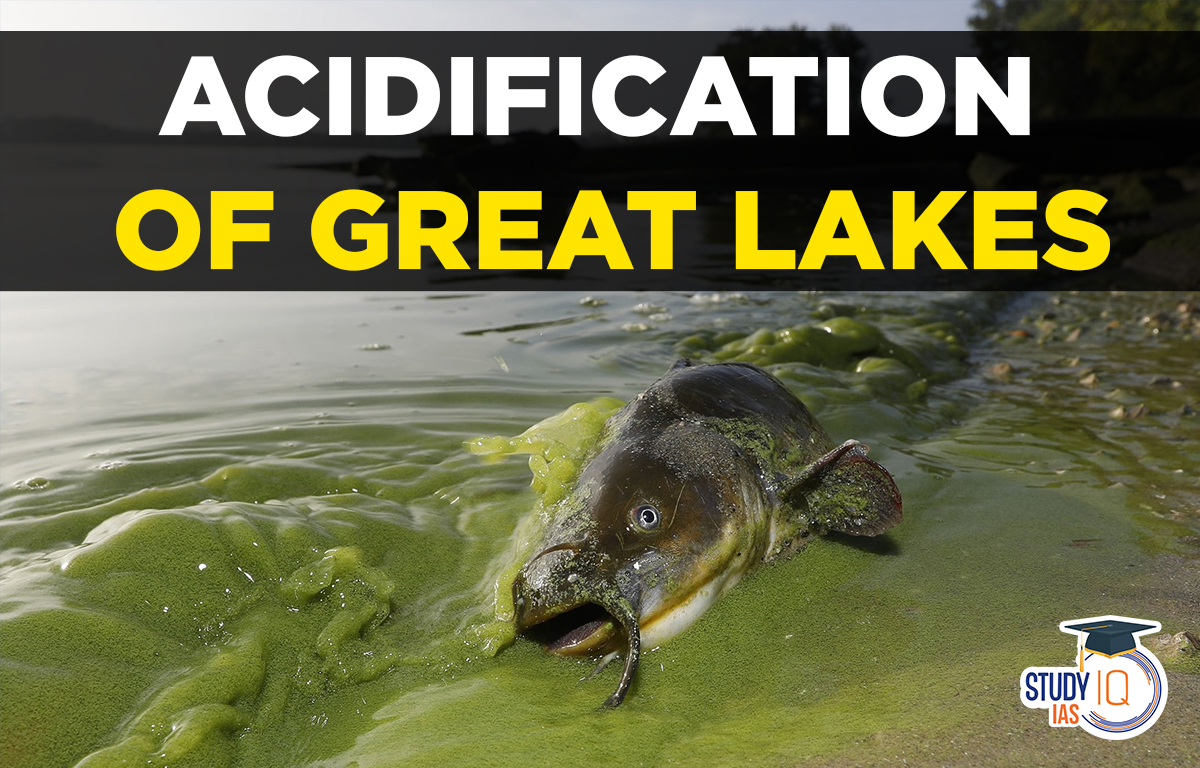Table of Contents
Background of Acidification of Great Lakes
- Scientists are building a sensor network to detect the trends in the water chemistry of Lake Huron.
- It is the first step towards developing a system that would be capable of measuring the carbon dioxide and pH levels of the Great Lakes over several years.
- Recently, it has been observed that by 2100, even the Great Lakes might approach acidity at around the same rate as the oceans.
The Great Lakes of US- Canada
- The Great Lakes are a series of interconnected freshwater lakes located in northeastern North America, on the Canada–United States border.
- The Great Lakes are believed to have been born some 20,000 years ago, when the Earth started to warm and water from melting glaciers filled the basins on its surface.
- They connect to the Atlantic Ocean via the St. Lawrence Seaway and the Gulf of the St. Lawrence.
- The Great Lakes from west to east: Superior, Michigan, Huron, Erie and Ontario. They are a dominant part of the physical and cultural heritage of North America.

- Features: Except for Lake Michigan, the lakes provide a natural border between Canada and the United States.
- Lake Superior is entirely a freshwater body, rendering it the largest freshwater lake in the world.
- Lake Huron is the second largest of the Great American Lakes after Superior. It is both the deepest and most voluminous of the Great Lakes of North America.
- Lake Michigan is the fourth largest lake in the world. It is also the largest lake contained within one country.
- Lake Erie is the smallest of the Great Lakes by volume, the shallowest and second-smallest in surface area.
- Presently, the Great Lakes contain a fifth of the world’s total freshwater, and is a crucial source of irrigation and transportation.
- Ecological importance: The Great Lakes also serve as the habitat for more than 3,500 species of plants and animals.
- The Great Lakes ecoregion contains a variety of habitats, including aquatic, forest, marsh, wetland, and dune ecosystems.
What is Acidification?
- Acidification of oceans or freshwater bodies takes place when excess carbon dioxide in the atmosphere gets rapidly absorbed into them.
- Absorption of carbon dioxide leads to a lowering of the pH, which makes the water bodies more acidic.
- The pH scale runs from 0 to 14, with 7 being a neutral pH.
- Anything higher than 7 is basic (or alkaline) and anything lower than 7 is acidic.
- According to the National Oceanic and Atmospheric Administration (NOAA) of the US Government, oceans in the last 200 years alone have become 30% more acidic.
- Over the years, a handful of computer modeling studies have suggested that atmospheric carbon might turn the Great Lakes and other freshwater bodies more acidic.

Consequences of Acidification
- Effects on ecosystem: Acidification may lead to a decrease in native biodiversity. It may create physiological challenges for organisms and permanently alter the structure of the ecosystem.
- Coral reefs: Acidification also endangers coral reefs and other marine life.
- Ship wrecks: It would also severely impact the hundreds of wooden shipwrecks that are believed to be resting at the bottom of these lakes.
- Skeletal organisms: Many ocean plants and animals build shells and skeletons out of two chemicals that exist in seawater, calcium and carbonate.
- Increased acidity slows the growth of calcium carbonate structures, and under severe conditions, can dissolve structures faster than they form.
- Survivability of marine organisms: Many marine fish and invertebrates have complex life cycles.
- Larvae are very small, which makes them especially vulnerable to increased acidity.
- Phytoplankton growth: Acidification may affect the growth of the photosynthetic phytoplankton that forms the basis of marine food webs.
Phytoplankton
- Phytoplankton, also known as microalgae, are similar to terrestrial plants in that they contain chlorophyll and require sunlight in order to live and grow.
- Most phytoplankton are buoyant and float in the upper part of the ocean, where sunlight penetrates the water.
- In a balanced ecosystem, phytoplankton provides food for a wide range of sea creatures including shrimp, snails, and jellyfish.
- When too many nutrients are available, phytoplankton may grow out of control and form harmful algal blooms (HABs).
Global Efforts to Reduce Acidification of Water Bodies
- Control carbon emissions: A collective global effort shall be needed to reduce concentrated atmospheric carbon dioxide. There is a greater need to arrest the increase in carbon emissions.
- Ecosystem conservation: Sustainable management, conservation and restoration of water bodies is needed.
- The UN (United Nations) Ocean Conference 2022 was recently held to ensure global cooperation towards protection and sustenance of the Ocean ecosystem of the world.
- Limiting global temperatures: Strenuous efforts to be made by countries to limit global warming to well below 2°C under the Paris Agreement.
- Realization of SDGs: Long-term observations and relevant experiments need to be carried out to achieve the target 14.3 of Sustainable Development Goal 14, which asks to “minimize and address the impacts of ocean acidification”.


 Securities Markets Code Bill 2025: Towar...
Securities Markets Code Bill 2025: Towar...
 Weakly Interacting Massive Particles (WI...
Weakly Interacting Massive Particles (WI...
 India–Oman Trade Deal: CEPA Signed to ...
India–Oman Trade Deal: CEPA Signed to ...

























